This article needs additional citations for verification .(February 2013) |
The guilder was the currency of British Guiana (initially known as Essequibo and Demerara) between 1796 and 1839.
This article needs additional citations for verification .(February 2013) |
The guilder was the currency of British Guiana (initially known as Essequibo and Demerara) between 1796 and 1839.
The Guianese guilder replaced the Dutch guilder at par after the colonies were captured by the British from the Dutch. The guilder was initially subdivided into 20 Stuivers , in English stivers. Brazilian peças (6,400 réis gold coins), known locally as joes, circulated at a value of 22 guilders. The exchange rate to the British pound was initially fixed at 1 pound = 12 guilders (1 guilder = 20 pence).
In 1836, the guilder was reduced in value to 16 pence and, in 1839, the British pound and British Guiana dollar replaced the guilder as the currency of British Guiana, at the rates of £1 = 15 guilders and $1 = 3+1⁄8 guilders (thus £1 = $4.8; $1 = 4s 2d, or 50d).

The first issue of coins from 1798 and 1799 were overstamps on Brazilian pecas. These were followed in 1808 by an issue which consisted of holed Spanish dollars, worth 3 guilders, and the plugs, worth 3 bits (equal to 15 stiver).
In 1809, regular coins were issued for Essequibo and Demerara in denominations of 1⁄4, 1⁄2, 1, 2 and 3 guilders, followed in 1813 by 1⁄2 and 1 stiver coins and 1⁄8 guilder coins from 1832.
1836 saw the introduction of a new series of coins denominated solely in guilders. This year also saw the first production of fourpenny coins by the British Royal Mint for use in British Guiana (worth ¼ guilder) which did not bear any indication of where the coins were to circulate (they later also circulated in the UK). Twopenny coins (worth ⅛ guilder) were issued in the same way from 1838.

In the 1830s, the colonies issued paper money denominated in joes and guilders. There were notes of 1, 2, 3 and 10 joes (22, 44, 66 and 220 guilders). It wasn’t until 1916 that the Government of British Guiana begin issuing dollar-denominated banknotes. [1] Banknotes produced specifically for British Guiana ceased in 1942, and were replaced by British West Indies dollars in 1951. In 1955, the British West Indies dollar was decimalized and issued in the name of the British Caribbean Territories, Eastern Group. In 1965, the East Caribbean dollar replaced the British West Indies dollar and circulated in British Guiana for a year until, following independence in 1966, the Guyanese dollar was introduced, replacing the East Caribbean dollar at par.
The Eastern Caribbean dollar is the currency of all seven full members and one associate member of the Organisation of Eastern Caribbean States (OECS). The successor to the British West Indies dollar, it has existed since 1965, and it is normally abbreviated with the dollar sign $ or, alternatively, EC$ to distinguish it from other dollar-denominated currencies. The EC$ is subdivided into 100 cents. It has been pegged to the United States dollar since 7 July 1976, at the exchange rate of US$1 = EC$2.70.
The British West Indies dollar (BWI$) was the currency of British Guiana and the Eastern Caribbean territories of the British West Indies from 1949 to 1965, when it was largely replaced by the East Caribbean dollar, and was one of the currencies used in Jamaica from 1954 to 1964. The monetary policy of the currency was overseen by the British Caribbean Currency Board (BCCB). It was the official currency used by the West Indies Federation The British West Indies dollar was never used in British Honduras, the Cayman Islands, the Turks and Caicos Islands, the Bahamas, or Bermuda.
The pound is the currency of Guernsey. Since 1921, Guernsey has been in currency union with the United Kingdom and the Guernsey pound is not a separate currency but is a local issue of sterling banknotes and coins, in a similar way to the banknotes issued in Scotland, England and Northern Ireland. It can be exchanged at par with other sterling coinage and notes.

The Jamaican dollar has been the currency of Jamaica since 1969. It is often abbreviated to J$, the J serving to distinguish it from other dollar-denominated currencies. It is divided into 100 cents, although cent denominations are no longer in use as of 2018. Goods and services may still be priced in cents, but cash transactions are now rounded to the nearest dollar.

The Trinidad and Tobago dollar is the currency of Trinidad and Tobago. It is normally abbreviated with the dollar sign $, or alternatively TT$ to distinguish it from other dollar-denominated currencies. It is subdivided into 100 cents. Cents are abbreviated with the cent sign ¢, or TT¢ to distinguish from other currencies that use cents. Its predecessor currencies are the Trinidadian dollar and the Tobagonian dollar.

The Guyanese dollar has been the unit of account in Guyana since 29 January 1839. Originally it was intended as a transitional unit to facilitate the changeover from the Dutch guilder system of currency to the British pound sterling system. The Spanish dollar was already prevalent throughout the West Indies in general, and from 1839, the Spanish dollar unit operated in British Guiana in conjunction with British sterling coins at a standard conversion rate of one dollar for every four shillings and twopence. In 1951 the British sterling coinage was replaced with a new decimal coinage which was simultaneously introduced through all the British territories in the Eastern Caribbean. When sterling began to depreciate in the early 1970s, a switch to a US dollar peg became increasingly attractive as an anti-inflationary measure and the Eastern Caribbean Currency Authority made the switch in October 1975. The Guyanese dollar is normally abbreviated with the dollar sign $, or alternatively G$ to distinguish it from other dollar-denominated currencies.
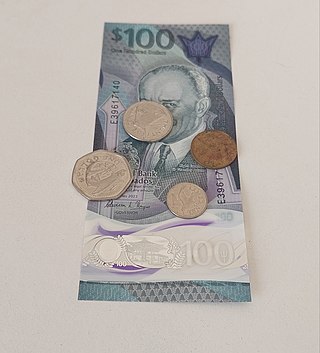
The dollar has been the currency of Barbados since 1935. Globally its currency has the ISO 4217 code BBD, however, unofficially in Barbados the International vehicle registration code BDS is also commonly used, a currency code that is otherwise reserved for Bangladesh outside Barbados. As such the present Barbados dollar has the official ISO 4217 code of BB which matches the [dot] .bb Cc-TLD domain names classification for Barbados under ISO 3166, plus D for dollar in the foreign exchange market. The Barbadian dollar is considered as a currency which can be divided into 100 cents, though the 1 cent coin is in the process of being phased out. In terms of population, Barbados is the third smallest country in the world after Tonga and the Seychelles to have an independent currency and monetary policy.
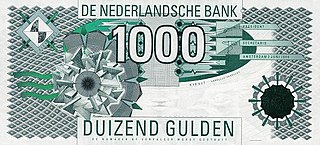
The guilder or florin was the currency of the Netherlands from 1434 until 2002, when it was replaced by the euro.

The Netherlands Antillean guilder is the currency of Curaçao and Sint Maarten, which until 2010 formed the Netherlands Antilles along with Bonaire, Saba, and Sint Eustatius. It is subdivided into 100 cents. The guilder was replaced on 1 January 2011 on the islands of Bonaire, Saba and Sint Eustatius by the United States dollar.

The rijksdaalder was a Dutch coin first issued by the Republic of the Seven United Netherlands in the late 16th century during the Dutch Revolt which featured an armored half bust of William the Silent. It was the Dutch counterpart of the Reichsthaler of the Holy Roman Empire but weighed slightly less, at 29.03 g of 0.885 fine silver, reduced to 0.875 fine by the 17th century. Friesland, Gelderland, Holland, Kampen, Overijssel, Utrecht, West Friesland, Zeeland, and Zwolle minted armored half bust rijksdaalders until the end of the 17th century.
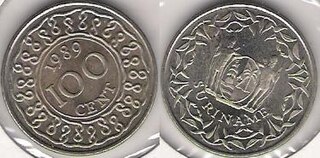
The guilder was the currency of Suriname until 2004, when it was replaced by the Surinamese dollar. It was divided into 100 cents. Until the 1940s, the plural in Dutch was cents, with centen appearing on some early paper money, but after the 1940s the Dutch plural became cent.
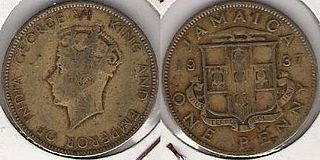
The pound was the official currency of Jamaica between 1840 and 1969. It circulated as a mixture of sterling coinage and locally issued coins and banknotes and was always equal to the pound sterling. The Jamaican pound was also used in the Cayman and Turks and Caicos Islands.
The pound was the currency of the Bahamas until 1966. It was equivalent to the pound sterling and was divided into 20 shillings, each of 12 pence. Standard sterling coinage circulated. Apart from a Bahamas penny coin struck in 1806, there were no special coin issues such as were found in Jamaica.
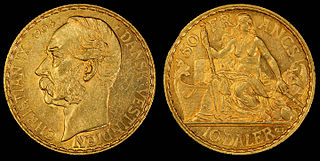
The daler was the currency of the Danish West Indies between 1849 and 1917, and of the United States Virgin Islands between 1917 and 1934.
The history of currency in the British colony of Dominica closely follows that of the British Eastern Caribbean territories in general. Even though Queen Anne's proclamation of 1704 brought the gold standard to the West Indies, silver pieces of eight continued to form a major portion of the circulating currency right into the latter half of the nineteenth century.
The history of currency in the British colony of Grenada closely follows that of the British Eastern Caribbean territories in general. Even though Queen Anne's proclamation of 1704 brought the gold standard to the West Indies, silver pieces of eight continued to form a major portion of the circulating currency right into the latter half of the nineteenth century.
The history of currency in the British colony of St. Kitts closely follows that of the British Eastern Caribbean territories in general. Even though Queen Anne's proclamation of 1704 brought the gold standard to the West Indies, silver pieces of eight continued to form a major portion of the circulating currency right into the latter half of the nineteenth century.
The history of currency in the British colony of Saint Vincent closely follows that of the British Eastern Caribbean territories in general. As such, it should not be considered in isolation. In order to get a broad overview of currency in the region, see the article British West Indies dollar.
The history of currency in the British colony of Saint Lucia closely follows that of the British Eastern Caribbean territories in general. Even though Queen Anne's proclamation of 1704 brought the gold standard to the West Indies, silver pieces of eight continued to form a major portion of the circulating currency right into the latter half of the nineteenth century.

Banknotes of Demerara and Essequibo, issued from 1809 through 1839 were dual-denominated in Guilders and Joes, a term used by the British colonists to refer to the Portuguese gold Johannes coin and the notes that eventually replaced them. Despite roughly 30 years of use, the only Joes known to exist are unissued remainders from the 1830s.